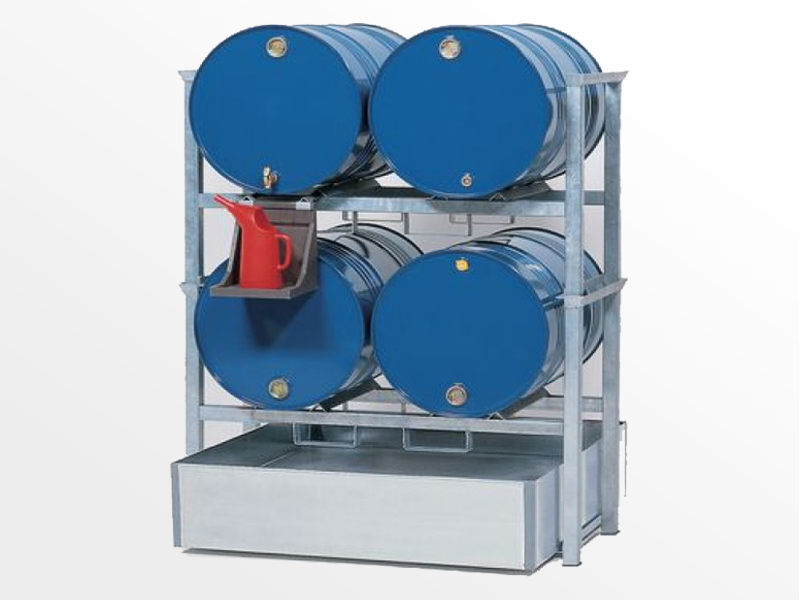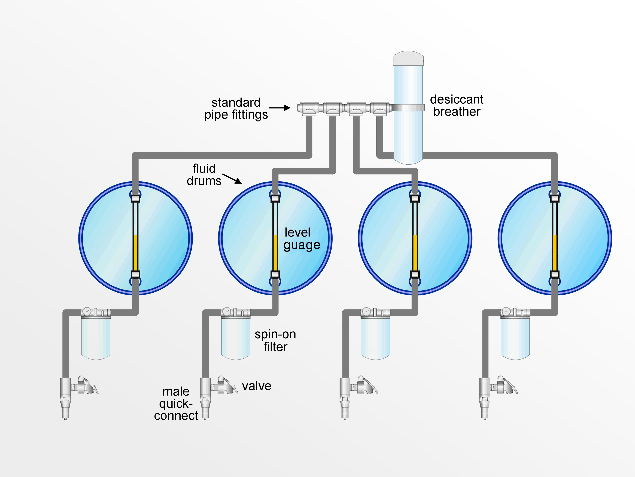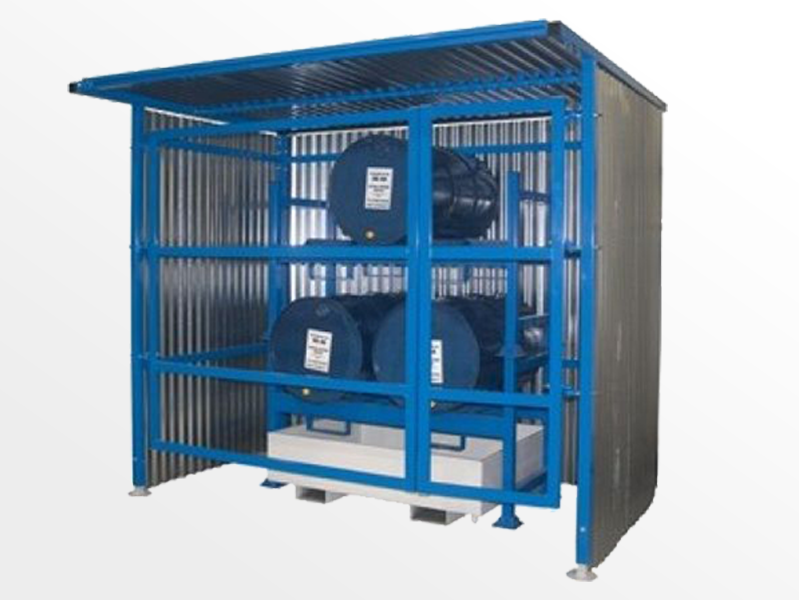Every day maintenance personnel in plants fill or top off systems with new lubricants. Their intention is to positively impact the life and performance of the equipment. Yet, unknowingly they often add mixed, chemically-depleted lubricants containing particulate, chemical and moisture contamination. Poor in-plant storage often lies at the root of these occurrences.
Just like bearings, gears or valves, lubricants should be considered working components in mechanical systems. Just as one would not install a dirty or damaged bearing on a piece of equipment using the wrong tools, "damaged" lubricants should not be added to the machine. The first step toward achieving proactive maintenance of your lubricants, and ultimately your equipment, begins with proper in-plant storage and handling.
Lubricants are packaged in many different forms to satisfy a wide variety of consumption rates and storage facilities. The four main industrial lubricant packages are pails (20 litres), drums (210 litres), totes (1000 litres) and bulk tanks.
What is your average consumption rate? Based on your historical consumption rates, you should be able to determine your average consumption over a period of time.
Maintain a safety stock that accounts for emergency refills and delivery delays.
What is the vendor's standard delivery time? Depending on the lubricant type, manufacturer and your plant location, average delivery can range from one day to two weeks. Some specialty fluids require even greater lead times. Make sure you know the typical delivery time when estimating ideal lubricant storage volumes. The quicker the delivery, the less you will need on-hand.
How much storage facility space do you have? Your storage space will help you determine which package types and volumes you can physically store. Try to ensure that a first-in/first-out (FIFO) inventory and usage system can easily be accommodated within your space limitations.
What is the condition of your storage facility? Storage environment and storage methods can greatly affect lubricant shelf life. As a rule of thumb, a clean and dry room with a steady, moderate temperature combined with proper storage racking will maximize lubricant shelf life. A dirty, moist environment with fluctuating temperatures will greatly reduce expected shelf life.
Most lubricants have supplier recommended shelf lives based largely upon the lubricant's additive package. For example, lubricants containing rust inhibitors may lose performance after as little as six months in storage. Conversely, some turbine fluids with a light additive dose may be shelved for up to three years. Shelf life information is available from your lubricant supplier and/or manufacturer for each product used. As previously discussed, employ a FIFO rotation of stored fluids to ensure that lubricant storage life is not accidentally exceeded. And, learn how to read the coded date on the container label. Shelf life is based on ideal storage conditions for your fluids. Most manufacturers provide a recommended storage procedure to maximize lubricant shelf life.
Temperature fluctuations will cause movement of air between the atmosphere and the head-space of the container (thermal siphoning). For partially full containers, with greater head-space, this air movement is increased. Although the drum is sealed and does not leak lubricant through the bung, a rigid container still inhales air when the temperature drops and exhales as the temperature rises. Along with the air, moisture and small airborne particles enter the oil container possibly leading to degradation of the base stock and additives. Also, water might condense within the drum, drop to the bottom and get pumped to the machine during a top-off.
Extreme hot or cold can cause chemical degradation. As mentioned earlier, rust inhibitors may suffer significant performance losses after only six months of normal storage. Depending upon the formulation, a rust inhibitor may have poor solubility in base oils leading to precipitation during storage. This precipitation is greatly accelerated during cold storage.
Petroleum-based lubricants are hygroscopic. When exposed to humid air, they naturally absorb airborne moisture. The moisture immediately begins to degrade the additive package and accelerates oxidation of the lubricant's base stock once it is put into service.
Temperature fluctuations will cause movement of air between the atmosphere and the head-space of the container (thermal siphoning). For partially full containers, with greater head-space, this air movement is increased. Although the drum is sealed and does not leak lubricant through the bung, a rigid container still inhales air when the temperature drops and exhales as the temperature rises. Along with the air, moisture and small airborne particles enter the oil container possibly leading to degradation of the base stock and additives. Also, water might condense within the drum, drop to the bottom and get pumped to the machine during a top-off.
Pails, drums and totes must be stored in a clean and dry location. Storage temperatures should remain moderate at all times. Lubricants in storage should be located away from all types of industrial contamination including dust and humidity. Bungs must be kept tight at all times and drum covers should be used whenever drums are stored in the upright position (bungs at 3 and 9 o'clock positions). Ideally, lubricants are stored in the horizontal position on proper storage racks allowing the containers to be rotated and used on a first-in, first-out basis (see Figure 1).
 Storage Racks. Racks of this type can be shop built or obtained commercially or in various heights and width. Drums can be conveniently moved onto and out of this rack with the stacker shown.
Storage Racks. Racks of this type can be shop built or obtained commercially or in various heights and width. Drums can be conveniently moved onto and out of this rack with the stacker shown.
While indoor storage of lubricants is recommended, this is not always possible due to environmental, financial or space constraints. If lubricants must be stored outdoors, track lubricant consumption carefully and replenish inventories "just-in-time" to minimize exposure to adverse conditions. If lubricants must be stored outside, shelter them from rain, snow and other elements. Lay drums on their sides with the bungs in a horizontal (3 and 9 o'clock) position below the lubricant level. This will greatly reduce the risk of the seals drying out and the ingestion of moisture caused by breathing (see Figure 2). If the drums must be placed upright in outdoor storage, employ drum covers or tilt drums to drain the moisture that gathers on the top around the bungs. Avoid outdoor storage of water-based fluids where extreme temperatures can have an even more damaging effect through freezing and evaporation.
Once the seal is broken and the container is put into use, care must be taken to ensure control over contamination ingress. If equipped with a proper pressure relief, bulk tanks should use filter breathers to control contamination ingestion. Drums and pails should be capped when not in use.

Two common consequences of lubricant mismanagement are cross contamination and lubricant confusion. All drums must be clearly labelled and stencilled to ensure proper product identification. Avoid using labelling methods that are not legible or may wear out over time. Take extra care in the labelling of containers that must be stored outdoors since the elements may damage the label. Colour coding labels simplifies the process, reducing the risk of misapplication. If a colour coding system is employed, be sure alpha or numeric information is also present to account for colour blindness.
Lubricant dispensing equipment often lies at the root of cross contamination problems. By dispensing oil through equipment that was previously used with a different lubricant, the two fluids mix, potentially causing lubrication impairment. Cross contamination is also a trend-killer, reducing the effectiveness of oil analysis efforts. Equipment such as transport containers, hand pumps, transfer carts and filter carts should be labelled to match the lubricant to be used with. Where mixing is unavoidable, verify compatibility in advance with the lubricant supplier. Extend the identification process to the machine’s lubricant fill ports. Using identification tags or color-codes helps to ensure that the proper lubricant is added to the reservoir fitted with the proper dispensing tools. If dispensing equipment must be used for a variety of lubricants, employ a proper cleaning or flushing procedure that emphasizes the removal of the previous lubricant and other contamination to minimize risk.
 When drums must be stored outside, a temporary shelter or lean-to, or water proof tarpaulin will protect them from rain or snow.
When drums must be stored outside, a temporary shelter or lean-to, or water proof tarpaulin will protect them from rain or snow.
Before dispensing stored lubricants in cases of storage stability risk, agitate them on a drum tumbler to re-suspend additives that may have fallen out during storage to ensure consistency in additive concentration. Use oil analysis to confirm the oil is in proper condition for service. This problem can be even more evident in large bulk oil systems where oil remains static for long periods of time. For these systems, a circulating system provides constant turnover to keep the additives evenly distributed. Equip such a circulating rig with dirt and water removal filters to further ensure protection.
In many cases, new oil is the dirtiest oil in the plant. The containers used to store lubricants are often reused and may be subjected to many extreme conditions before they reach your plant. Currently, lubricant manufacturers are not required to ensure cleanliness of the lubricant they provide unless it is advertised as meeting a specified cleanliness rating, or cleanliness is written into the lubricant purchase specification, the new oil contamination level is frequently too high for immediate service without conditioning. Routine analysis of new oils should be employed to ensure effective contamination control.
Lubricants in storage are also subject to particle agglomeration. Agglomeration occurs when smaller particles combine to form larger, more harmful particles. These harmful particles will typically fall to the bottom of the container. Remember that while drum agitation is effective at re-suspending additives, it is also effective at re-suspending settled contamination.
Even when taking the best care possible to store lubricants, they are subject to contamination ingression when filling or topping up systems. Therefore it is absolutely necessary that the lubricant be filtered with an appropriate filter element prior to entering your equipment. Here are some lubricant dispensing tips:
Be sure that the proper transfer equipment is being used for the lubricant being dispensed. Whether you are top- ping up your system directly or filling a smaller portable container, be sure that the lubricant has been filtered.
It is recommended that the oil be cycled through a high efficiency filter element with a beta rating matching your equipment requirements. If your storage method exposes the lubricant to moist environments, two-stage filtering with a water absorbing filter element is highly recommended.
When transferring lubricants to portable containers, be sure to avoid the use of galvanized containers since the additive in the lubricant may react with the zinc plating, forming metal soaps that clog small openings and orifices in industrial machinery.
Avoid using open or dirty containers for transfer purposes. Use properly identified, capped containers for low volume transfers.
An effective proactive maintenance program mandates effective storage and delivery of lubricants. Protecting your lubricants, and ultimately your equipment, from the harmful effects of contamination and lubricant degradation begins with proper in-plant storage. To ensure suitable storage of lubricants, containers should be stored indoors in a dry location where temperatures remain moderate at all times. Clearly identify lubricants and machine application to avoid confusion and the misapplication of products. And, be sure that the proper transfer equipment and procedures are employed for that specific lubricant. These simple steps can substantially impact the useful life of your lubricants and your equipment.